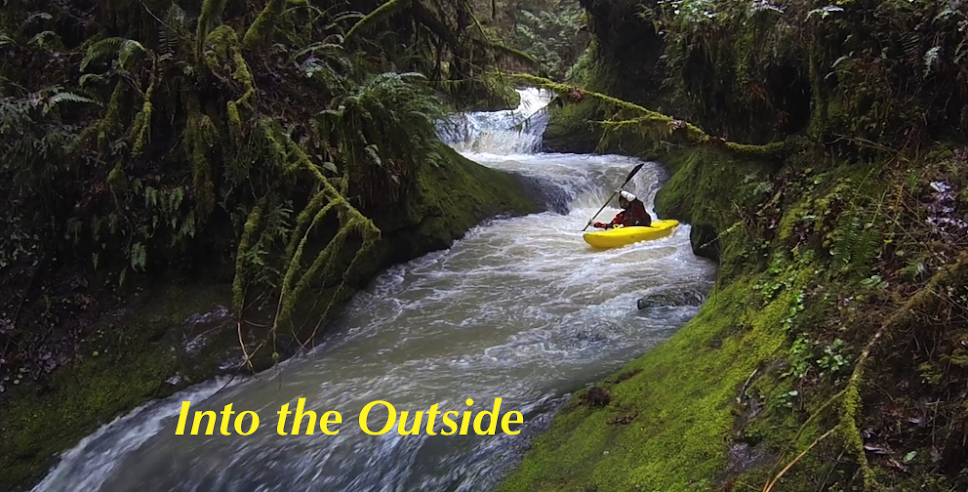Stream: From the Pool below Twister Falls there is a short section of class III-IV warm up before a scout at the EF of Eagle Creek confluence. Both the main channel and the EF channel can be run. Just downstream is Grand Union Falls, a 50-ish foot ramp into freefall ending in a big pool.
Photo: Paul Thomson
Photo: Paul Thomson
2 miles of read and run boulder gardens lead to Skoonichuck Falls (you are getting close when you cross under a foot bridge). Scout from either side, but left is more common. This 50-ish foot double is usually run with a delayed boof in the middle for the first their, then wherever the current sends you for the second one. The top drop can also be run left. At least one person has ended up behind the veil but this is uncommon.
The pool exiting Skoonichuck is class III-ish but it is imperative that boaters get to the left bank after it ASAP. The current gets shallow here and funnels into a narrow chute on the right that has a log wedged in it. Boaters need to get left and go over a shallow slide.
Between here and the High Bridge gorge are three rapids, the first can be scouted from the right. The second is run off the point just on the left side of the current (45 degree angle to absorb the shelf it lands on), and the third is run along the left bank.
A short and beautiful float through the narrow High Bridge gorge brings you to a tiered rapid best finished on the far right to avoid a hole. The top tier is odd so take a look from river left.
A mile of read and run brings you to a 10 foot ledge, easily scouted on the right. Just below here is the entrance to Punchbowl Falls. There is a shallow class II entry slide, the eddies are small and soft so go one at a time.
Scout Punchbowl from the left, I like to run the lead-in ledge on the right with a left stroke. Then for the main drop most people like to drive up onto the boil and hold a right stroke going off. People used to take a right side meltdown sometimes, but that's not very common anymore.
It's a tricky lip so analyze it thoroughly. The hit can be hard, but good lines usually result in reasonable impacts.
It's worth spending some time in this punchbowl. Float around the corner and take out above the next horizon. If you want to portage Metlako without doing a throw and go, take the spur trail found here back up to the main one and head downstream. Immediately after passing the second narrow cliff section there will be a way back down to the creek via a scree slope. There is usually an animal style path helping the cause on the downstream end of this scree slope. Below here it is class II-III to the take out at the low head dam.
If you are not portaging, scout Lower Punchbowl and run off the center-right flake.
There are two rapids between here and Punchbowl, the first one is run center and is III-IV depending on flows. The second is a small riverwide ledge. Run this ledge as far left as you can (even if you have to scrape). There is a hundred feet of flatwater between here and Metlako. Scout from the platform on the left. It is possible to attain back upstream from here at lower flows, but it take some effort.
Here are a variety of Metlako lines, high water means a softer landing but a more hazardous pool (0:55). The throw and go is intimidating but fine. Try to land in the boil.
The pool here is another special place, enjoy it if you have the time. Easy floating leads to another horizon, it's an easy portage on the left. Not sure if this ugly drop has been run, probably I'd guess.
Just downstream the creek leaves the gorge and meets up with the portage route. There is one class III rapid and the rest is class II down to the take out at the low had dam.
Flows: Use the Bull Run Nr Multnomah Falls gauge. 400-700 is SOP, but 1,000 cfs is doable.
Flows: Use the Bull Run Nr Multnomah Falls gauge. 400-700 is SOP, but 1,000 cfs is doable.
Access: Take exit 41 off Hwy 84 East (no access heading West). Turn right and follow the road to it's end in about 1/2 mile. Find a parking spot and pay the $5 fee. Hike up the trail until you reach your put in.
Hiking distance to put-ins
Full Run (Base of Twister Falls): 5 1/4 miles
Standard (Skoonichuck Falls): 3 1/2 miles
Hike and Huck (Puncbowl Falls): 2 miles
----------------------------------------------------------------------------------------------------------------------------------------------
Original Write-up
----------------------------------------------------------------------------------------------------------------------------------------------
----------------------------------------------------------------------------------------------------------------------------------------------
After running different section of Eagle Creek for years, Matt finally got the ball rolling and convinced us to hike past the conventional Skoonichuck put in, tracing the footsteps of the Preistly brothers, Ryan Scott and their friends to tackle the upper waterfalls. The link below is to a Canoe & Kayak article about that trip.
After doing this trip, I now consider the true Eagle Creek run to begin at the base of Twister Falls. Putting in lower is cutting out some good stuff, putting in higher lowers the fun:dealing ratio below the threshold of classic. That said, all sections are enjoyable days in a kayak, tube, or swimming. If you want to get vertical, this stream will leave you satisfied.











